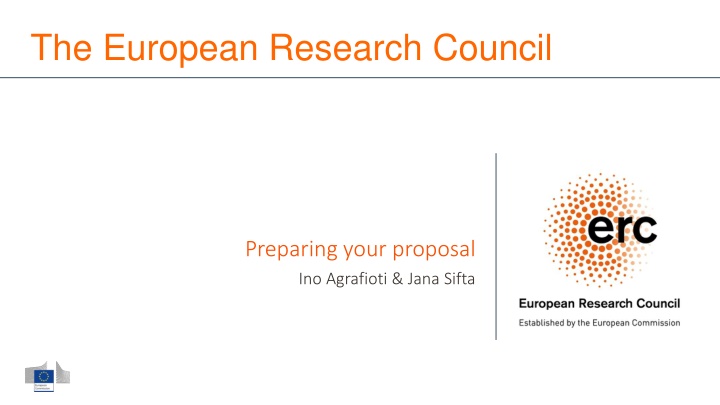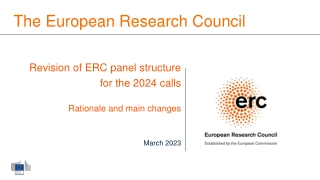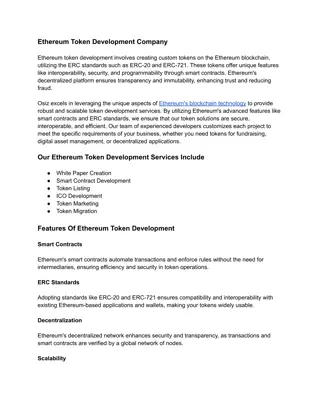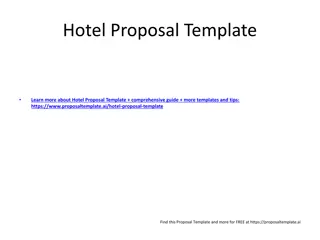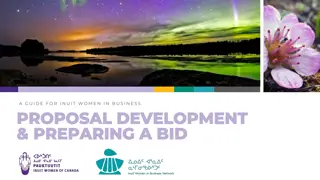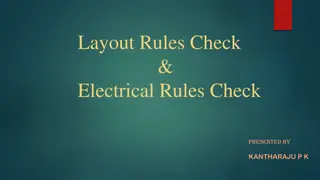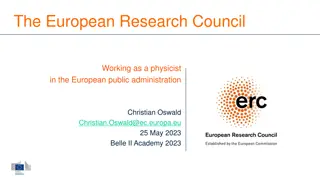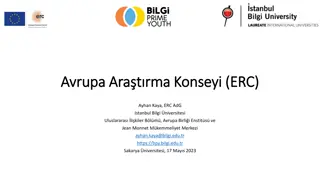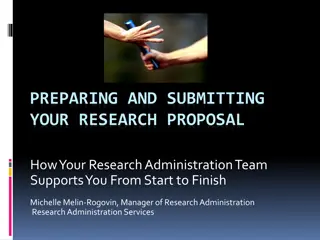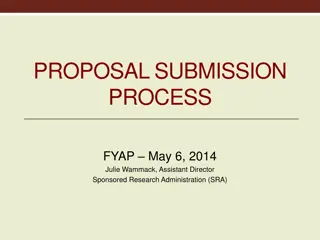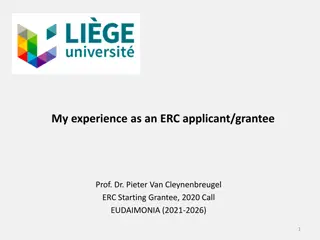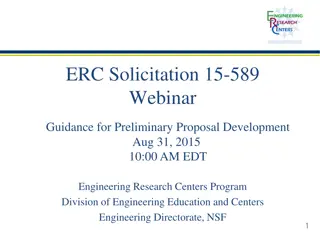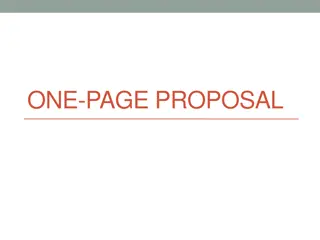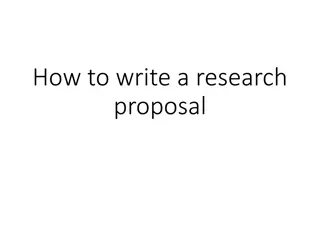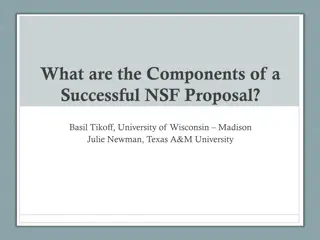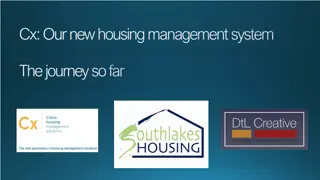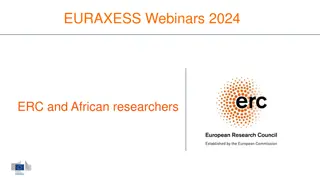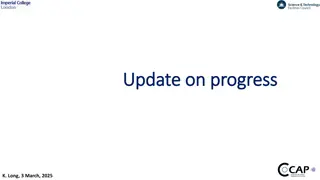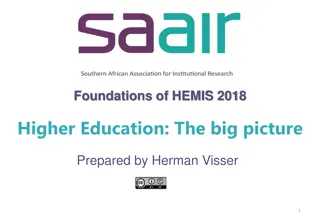Preparing Your ERC Proposal - First Steps
Get prepared for your European Research Council (ERC) proposal by familiarizing yourself with the Funding and Tender portal, downloading necessary templates, and choosing the right evaluation panel for your research topic. Understand the importance of selecting the appropriate panel and how proposals are assessed based on scientific excellence. Ensure your interdisciplinary proposal is well-explained to potentially transfer between panels if needed.
Download Presentation

Please find below an Image/Link to download the presentation.
The content on the website is provided AS IS for your information and personal use only. It may not be sold, licensed, or shared on other websites without obtaining consent from the author.If you encounter any issues during the download, it is possible that the publisher has removed the file from their server.
You are allowed to download the files provided on this website for personal or commercial use, subject to the condition that they are used lawfully. All files are the property of their respective owners.
The content on the website is provided AS IS for your information and personal use only. It may not be sold, licensed, or shared on other websites without obtaining consent from the author.
E N D
Presentation Transcript
The European Research Council Preparing your proposal Ino Agrafioti & Jana Sifta
First things first: get information (early on)! Get familiar with the European Commission's Funding and Tender portal and download the templates https://ec.europa.eu/info/funding-tenders/opportunities/portal/screen/home Call documents (Information for Applicants, Work Programme, Frequently Asked Questions) explain how to prepare your proposal Ask your questions NCPs Host Institutions grant offices ERC grantees ERCEA e.g., ERC-2024-ADG-APPLICANTS@ec.europa.eu , ERC-2025-COG- APPLICANTS@ec.europa.eu 2
Physical Sciences & Engineering PE1 Mathematics PE2 Fundamental Constituents of Matter PE3 Condensed Matter Physics PE4 Physical and Analytical Chemical Sciences PE5 Synthetic Chemistry and Materials PE6 Computer Science and Informatics PE7 Systems and Communication Engineering PE8 Products and Process Engineering PE9 Universe Sciences PE10 Earth System Science PE11 Materials Engineering Step 2: choose your Panel Evaluation Panel Structure 2024 Life Sciences LS1 Molecules of Life: Biological Mechanisms, Structures and Functions LS2 Integrative Biology: From Genes and Genomes to Systems LS3 Cell Biology, Development, Stem Cells and Regeneration LS4 Physiology in Health, Disease and Ageing LS5 Neuroscience and Disorders of the Nervous System LS6 Immunity, Infection and Immunotherapy LS7 Prevention, Diagnosis and Treatment of Human Diseases LS8 Environmental Biology, Ecology and Evolution LS9 Biotechnology and Biosystems Engineering Social Sciences and Humanities SH1 Individuals, Markets and Organisations SH2 Institutions, Governance and Legal Systems SH3 The Social World and Its Interactions SH4 The Human Mind and Its Complexity SH5 Texts and Concepts SH6 The Study of the Human Past SH7 Human Mobility, Environment, and Space SH8 Studies of Cultures and Arts 3
Choosing the right right Panel is very important! Proposals are initially assigned to the Panel of the PI's choice. The PI can flag one Secondary Review Panel the PI must explain the interdisciplinary nature of the proposal in the special section in the first page of Part B1. Transfer of proposals between panels may occur if: there is a clear mistake on part of the applicant. the necessary expertise is available in a different panel. Both Panel Chairs must agree on the transfer! Both Panel Chairs must agree on the transfer! Rumour: The panel descriptors represent ERC scientific priorities NOT true: The panel descriptors are indicative so that PIs can see what expertise is in the Panel. It is the PIs that choose the subject of their proposal and the Panels use the excellence criterion to judge whether it should be funded. Rumour: Choose the panel "strategically in order to increase chances of success NOT true: Choose the panel that best fits the proposal. The budget is distributed among the scientific panels as a function of demand success rate is equal amongst panels! 4
Step 3: Start writing PART A PART A admin forms online admin forms online PART B1 PART B1 submitted as .pdf submitted as .pdf Section 1 Proposal and PI info Section 2 Host Institution info Section 3 Budget Section 3 Budget Section 4 Ethics Section 5 Call-specific Questions Abstract and Cross-Panel explanation 1 p. Extended Synopsis CV & Track Record up to 4 p. 5 p. Seen by the panel Annexes Annexes submitted as . submitted as .pdf pdf PART B2 PART B2 submitted as . submitted as .pdf pdf Statement of support of HI copy of PhD or equiv. (StG & CoG) Scientific Proposal Funding ID 14 p. 1 p. If applicable: document for extension of eligibility window (StG & CoG) explanatory info on ethical issues
Choose your descriptors and free keywords carefully in Part A! Rumour: The more cross-panel descriptors I indicate, the higher the funding chances, since I emphasize like this the interdisciplinarity of my proposal. NOT true: even though these are used to allocate proposals to Panel Members, once the proposals are allocated, the Panel Members do not see the keywords and descriptors used. Descriptors and free keywords influence which Panel will evaluate your proposal are the basis of allocation to the panel members will determine whether a cross-panel evaluation is necessary 6
CV and Track Record 1. No prescriptive Principal Investigator profiles Instead, 3 sections PERSONAL DETAILS PI s education and key qualifications, current position(s) and relevant previous positions they have held. RESEARCHACHIEVEMENTS (<=10) AND PEER RECOGNITION demonstrating advancement in the field, with emphasis on more recent achievements prizes, fellowships, academy membership, etc. The applicant can provide a short, factual narrative short, factual narrative on the significance of the listed achievements and recognitions in relation to the research field and the proposed project. ADDITIONAL INFORMATION Relevant additional information on their research career to provide context when assessing their research achievements and peer recognition. career breaks, diverse career paths, life events other noteworthy contributions to research community 2. 3. 7
When writing your CV and Track Record Use the recommended template with the 3 sections as much as possible. The CV/Track Record part of B1 is still very important, so do put time and effort in it. Tell your story! Explain what has been your own contribution to your publications/how they have impacted the field. Convince the panel that you are the forefront of your research field this may be (very) different for different people so make sure you highlight your key strengths and accomplishments. Are you internationally internationally active? i.e. speaker in international conferences? Do you have any international collaborations? (mobility is not a criterion!) Explain publishing habits in your field and country if needed. Describe accurately any other activity that can indicate scientific maturity. If you know that you have gaps or other issues in your CV, explain them in the Additional Information section. 8
When writing your CV and Track Record Rumour 1: You can only apply for an ERC grant if you are a highly accomplished researchers. NOT true: Accomplishments are appreciated in relation to your stage/seniority as giving some evidence of your capacity to conduct the research you propose and of creativity. Rumour 2: One needs publications in Nature/Science/High IF journals to succeed. NOT true: however, publishing with senior scientists (former supervisors) may raise doubts about maturity/scientific independence. Rumour 3: One needs to say how many people they have supervised. NOT true: The Scientific Council concluded that the supervision element becomes a proxy that is in part a reflection of the excellence of the environment rather than the research team leader. Rumour 4: The quality/fame of the HI is increasing my chances/scores. NOT true: the HI is not an evaluation criterion! 9
CV and Track Record https://erc.europa.eu/news-events/news/evaluation-research-proposals-why-and-what-ercs-recent-changes 10
Research Project Streamlined evaluation questions No explicit reference to high-risk/high-gain Instead: ground-breaking, ambitious, and feasible . The ERC will always encourage risky research. The ERC will always encourage risky research. No explicit reference to novel methodologies Novel methodologies is an element that may be positive but is not strictly necessary for an excellent proposal. 11
Part B1 is all about finding the right balance Step 1 discussions are based on remote assessment of Part B1 Record/CV Record/CV - - by Panel members only Panel members only. They are asked to look at FEASIBILITY. Part B1 consisting of the Synopsis Synopsis and Track FEASIBILITY. Track Part B1 gives the first impression of your project/yourself. Part B1 will determine if you pass to Step 2. Part B1 is a synopsis of the project so it should include all Use full space available (5 pages) all main elements. 12
Questions to ask yourself (1) Is my project new, innovative, bringing in new solutions/theories? Does it promise to go substantially beyond the state of the art? Something significant will last, not just something that will be improved in 5 years (one major step better then several small steps). Think Big! Make sure that your idea needs an ERC to do it! significant, that Why is my project important? Answering a complete question (not only what but also why ) Is it timely? (Why wasn't it done in the past?) 13
Questions to ask yourself (2) How can I prove/support my case? Do I have a hypothesis? Do I have supporting evidence? Have I proven the project's feasibility? Are my goals realistic? What's the risk risk? Make sure that your risk is not too early on in the project. Do and redo the structure of the WPs WPs* until you are fully convinced. Have I proposed alternatives? risk? Is it justified by a substantial potential gain? Do I have a plan for managing the Why am I the best/only person to carry it out? Know your competitors what is the state of play, and why is your idea and scientific approach outstanding compared to them? Have I given a realistic picture of my collaborations? Show that you can drive the collaborations but that it is you who will be leading the project. Attention: Get written consent of your collaborators before the submission deadline (a simple email is OK) 14
Some more rumours Rumour 1: I need preliminary results. NOT true: You do not, however you need to explain how the literature supports your hypothesis. Rumour 2: To be successful, you need to continue an established research line, to prove continuity and credibility NOT true: Generally, the opposite is true. Rumour 3: If you have already obtained on ERC grant you are less/more likely to get another one. NOT true: Panels look at each proposal on its own merit and in comparison with the other applications, irrespectively of whether you have or have not obtained an ERC grant in the past. (Of course this does not apply for applications to a Proof of Concept grant.) Rumour 4: The more socially or medically relevant a proposal is, the higher the chances of it getting funded. NOT true: ERC funds frontier research, not research that promises to be only an incremental advancement of knowledge. This is irrespective of the field and whether it has societal, medical or clinical applications. 15
Part B2 is for filling in the details Step 2 interview and discussions are based on remote assessment of both Parts B1/B2 members AND external reviewers members AND external reviewers. In Step 2, they are asked to look at METHODOLOGY. Parts B1/B2 by Panel METHODOLOGY. Panel Do not repeat the synopsis Do not repeat the synopsis: go instead into details on your methodology and work plan! (Panel Members remember the Part B1 they read at step 1 and external reviewers read both B1/B2 consecutively.) Make sure that there is an obvious link between B1 and B2. Further explain your hypothesis and/or provide supporting evidence (if it exists) Show you did your homework homework! Make sure that the quantitative and qualitative differences to the state-of-the-art are clear and referenced Make sure that that literature summary is as complete as possible Provide more information on the alternative strategies to mitigate the risks. 16
Part B2 is for filling in the details Describe some sort of timeline Think the project as a team - explain involvement of team members and collaborators (be careful though: ERC proposals are NOT consortium proposals) Use full space available (14 p.) Make sure you give full references (these are excluded from page count so there is no excuse) Fill in your Funding ID fully. 17
Respect the reader so that the reader can respect you Make the project "easy to read and attractive" Use paragraphs and correct typos Do not submit a document with track changes Avoid jargon No excessive highlighting Do not oversell it Check the coherence of figures/tables Make sure that there are proper legends to figures/tables as well as that the figure axes are clearly visible 18
Explain properly your resources and budget Budget analysis carried out in Step 2/Step 3 of the evaluation. Panels have responsibility to ensure that resources requested are reasonable and well justified. Budget cuts need to be justified on a proposal-by-proposal basis (no across-the-board cuts). Costs are often cut when they have not been explained. Panels do not micro-manage project finances. Awards made on a take-it-or-leave-it basis: no negotiations. Ask for funding for Open Access this is obligatory in HorizonEurope! Rumour 1: If I do not ask for a large sum, I have no chances- only complex and expensive projects get funded. NOT true: There are many areas where it may make little or no sense to ask for the maximal amount of funds. No grant was ever rejected for asking too few funds. Rumour 2: Ask for funding beyond the max, the panel will anyhow cut it down. NOT true: unexplained or non-motivated requests can be cut down, so if you artificially inflate your budget, the extra funding will be indeed cut. 19
Pilot lump sum model for the Advanced Grant call 2024 https://www.youtube.com/live/oKhCdAavkMI?si=D3RMHgxAoBxYOzrS 20
Final step: submit! A submitted proposal can be revised and overwriting the previous one. revised until the call deadline until the call deadline by submitting a new version Once you submit, all you need to do is wait! It's our turn to do the work!
Typical reasons for rejection a summary Research Project Research Project Scope: Too narrow too broad/unfocussed Incremental research Collaborative project, several PIs Work plan not detailed enough/unclear Insufficient risk management Part B2 did not give sufficient information on the methodology If rejected, KEEP TRYING Reapplications have a higher success rate Use the feedback from evaluation reports Principle Investigator Principle Investigator Insufficient track-record You did not apply You did not apply
Not leaving it to the last minute means that you could re-apply in the same call success rates are flat Rumour: I should wait until the end of the eligibility window in order to accumulate enough seniority: only then I will be competitive. NOT true: The success rate is virtually flat across the eligibility window (StG, CoG). STG COG ADG 2020 Grantees by years since PhD 60% 220 200 STG 50% 180 COG # grantees 160 40% 140 ADG 120 30% Success rate 100 20% 80 60 10% 40 20 0% 0 2 3 4 5 6 7 8 9 10111213141516171819202122232425262728293031323334353637383940414243444546 # Yrs since PhD
